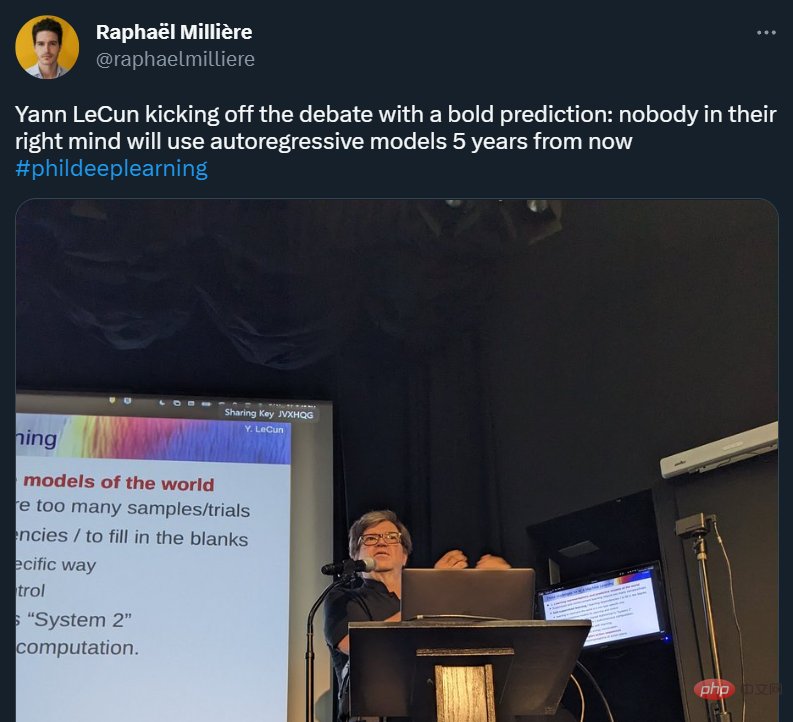 Technology peripherals
Technology peripherals AI
AI For only $250, Hugging Face's technical director teaches you how to fine-tune Llama 3 step by step
For only $250, Hugging Face's technical director teaches you how to fine-tune Llama 3 step by step
We are familiar with open source large language models such as Llama 3 launched by Meta, Mistral and Mixtral models launched by Mistral AI, and Jamba launched by AI21 Lab, which have become competitors of OpenAI. .
In most cases, users need to fine-tune these open source models based on their own data to fully unleash the model's potential.
It is not difficult to fine-tune a large language model (such as Mistral) compared to a small one using Q-Learning on a single GPU, but efficient fine-tuning of a large model like Llama 370b or Mixtral has remained a challenge until now.
Therefore, Philipp Schmid, technical director of Hugging Face, explains how to fine-tune Llama 3 using PyTorch FSDP and Q-Lora, with the help of Hugging Face's TRL, Transformers, peft and datasets libraries. In addition to FSDP, the author also adapted Flash Attention v2 after PyTorch 2.2 update.
The main steps for fine-tuning are as follows:
- Set up the development environment
- Create and load the data set
- Use PyTorch FSDP, Q-Lora and SDPA for fine-tuning Large language model
- Test the model and perform inference
Please note: The experiments conducted in this article were created and verified on NVIDIA H100 and NVIDIA A10G GPUs. Profiles and code are optimized for 4xA10G GPUs, each with 24GB of memory. If the user has more computing power, the configuration file (yaml file) mentioned in step 3 needs to be modified accordingly.
FSDP Q-Lora background knowledge
Based on the collaborative project jointly participated by Answer.AI, Q-Lora founder Tim Dettmers and Hugging Face, the author has a deep understanding of Q-Lora and PyTorch FSDP (fully shared The technical support provided by data parallelism is summarized.
The combination of FSDP and Q-Lora allows users to fine-tune Llama 270b or Mixtral 8x7B on 2 consumer-grade GPUs (24GB). For details, please refer to the article below. Among them, the PEFT library of Hugging Face plays a vital role in this.
Article address: https://www.answer.ai/posts/2024-03-06-fsdp-qlora.html
PyTorch FSDP is a data/model parallel technology, which Models can be split across GPUs, reducing memory requirements and enabling larger models to be trained more efficiently. Q-LoRA is a fine-tuning method that leverages quantization and low-rank adapters to efficiently reduce computational requirements and memory footprint.
Set up the development environment
The first step is to install Hugging Face Libraries and Pyroch, including libraries such as trl, transformers and datasets. trl is a new library built on transformers and datasets that makes fine-tuning, RLHF, and alignment of open source large language models easier.
# Install Pytorch for FSDP and FA/SDPA%pip install "torch==2.2.2" tensorboard# Install Hugging Face libraries%pip install--upgrade "transformers==4.40.0" "datasets==2.18.0" "accelerate==0.29.3" "evaluate==0.4.1" "bitsandbytes==0.43.1" "huggingface_hub==0.22.2" "trl==0.8.6" "peft==0.10.0"
Next, log in to Hugging Face to get the Llama 3 70b model.
Creating and loading data sets
After the environment is set up, we can start creating and preparing data sets. The microinvocation data set should contain sample samples of the tasks the user wants to solve. Read How to fine-tune LLM with Hugging Face in 2024 to learn more about creating the dataset.
Article address: https://www.philschmid.de/fine-tune-llms-in-2024-with-trl#3-create-and-prepare-the-dataset
The author used the HuggingFaceH4/no_robots data set, which is a high-quality data set containing 10,000 instructions and samples, and has undergone high-quality data annotation. This data can be used for supervised fine-tuning (SFT) to make language models better follow human instructions. The no_robots dataset is modeled after the human instructions dataset described in the InstructGPT paper published by OpenAI, and consists primarily of single-sentence instructions.
{"messages": [{"role": "system", "content": "You are..."}, {"role": "user", "content": "..."}, {"role": "assistant", "content": "..."}]}{"messages": [{"role": "system", "content": "You are..."}, {"role": "user", "content": "..."}, {"role": "assistant", "content": "..."}]}{"messages": [{"role": "system", "content": "You are..."}, {"role": "user", "content": "..."}, {"role": "assistant", "content": "..."}]}no_robots The 10,000 samples in the data set are divided into 9,500 training samples and 500 test samples, some of which do not contain system information. The author used the datasets library to load the datasets, added missing system information, and saved them into separate json files. The sample code looks like this:
from datasets import load_dataset# Convert dataset to OAI messagessystem_message = """You are Llama, an AI assistant created by Philipp to be helpful and honest. Your knowledge spans a wide range of topics, allowing you to engage in substantive conversations and provide analysis on complex subjects."""def create_conversation(sample):if sample["messages"][0]["role"] == "system":return sampleelse:sample["messages"] = [{"role": "system", "content": system_message}] + sample["messages"]return sample# Load dataset from the hubdataset = load_dataset("HuggingFaceH4/no_robots")# Add system message to each conversationcolumns_to_remove = list(dataset["train"].features)columns_to_remove.remove("messages")dataset = dataset.map(create_conversation, remove_columns=columns_to_remove,batched=False)# Filter out conversations which are corrupted with wrong turns, keep which have even number of turns after adding system messagedataset["train"] = dataset["train"].filter(lambda x: len(x["messages"][1:]) % 2 == 0)dataset["test"] = dataset["test"].filter(lambda x: len(x["messages"][1:]) % 2 == 0)# save datasets to diskdataset["train"].to_json("train_dataset.json", orient="records", force_ascii=False)dataset["test"].to_json("test_dataset.json", orient="records", force_ascii=False)使用 PyTorch FSDP、Q-Lora 和 SDPA 来微调 LLM
接下来使用 PyTorch FSDP、Q-Lora 和 SDPA 对大语言模型进行微调。作者是在分布式设备中运行模型,因此需要使用 torchrun 和 python 脚本启动训练。
作者编写了 run_fsdp_qlora.py 脚本,其作用是从磁盘加载数据集、初始化模型和分词器并开始模型训练。脚本使用 trl 库中的 SFTTrainer 来对模型进行微调。
SFTTrainer 能够让对开源大语言模型的有监督微调更加容易上手,具体来说有以下几点:
格式化的数据集,包括格式化的多轮会话和指令(已使用)只对完整的内容进行训练,忽略只有 prompts 的情况(未使用)打包数据集,提高训练效率(已使用)支持参数高效微调技术,包括 Q-LoRA(已使用)为会话级任务微调初始化模型和分词器(未使用,见下文)
注意:作者使用的是类似于 Anthropic/Vicuna 的聊天模板,设置了「用户」和「助手」角色。这样做是因为基础 Llama 3 中的特殊分词器( 及 )没有经过训练。
这意味着如果要在模板中使用这些分词器,还需要对它们进行训练,并更新嵌入层和 lm_head,对内存会产生额外的需求。如果使用者有更多的算力,可以修改 run_fsdp_qlora.py 脚本中的 LLAMA_3_CHAT_TEMPLATE 环境变量。
在配置参数方面,作者使用了新的 TrlParser 变量,它允许我们在 yaml 文件中提供超参数,或者通过明确地将参数传递给 CLI 来覆盖配置文件中的参数,例如 —num_epochs 10。以下是在 4x A10G GPU 或 4x24GB GPU 上微调 Llama 3 70B 的配置文件。
%%writefile llama_3_70b_fsdp_qlora.yaml# script parametersmodel_id: "meta-llama/Meta-Llama-3-70b" # Hugging Face model iddataset_path: "."# path to datasetmax_seq_len:3072 # 2048# max sequence length for model and packing of the dataset# training parametersoutput_dir: "./llama-3-70b-hf-no-robot" # Temporary output directory for model checkpointsreport_to: "tensorboard" # report metrics to tensorboardlearning_rate: 0.0002# learning rate 2e-4lr_scheduler_type: "constant"# learning rate schedulernum_train_epochs: 3# number of training epochsper_device_train_batch_size: 1 # batch size per device during trainingper_device_eval_batch_size: 1# batch size for evaluationgradient_accumulation_steps: 2 # number of steps before performing a backward/update passoptim: adamw_torch # use torch adamw optimizerlogging_steps: 10# log every 10 stepssave_strategy: epoch # save checkpoint every epochevaluation_strategy: epoch # evaluate every epochmax_grad_norm: 0.3 # max gradient normwarmup_ratio: 0.03 # warmup ratiobf16: true # use bfloat16 precisiontf32: true # use tf32 precisiongradient_checkpointing: true # use gradient checkpointing to save memory# FSDP parameters: https://huggingface.co/docs/transformers/main/en/fsdpfsdp: "full_shard auto_wrap offload" # remove offload if enough GPU memoryfsdp_config:backward_prefetch: "backward_pre"forward_prefetch: "false"use_orig_params: "false"
注意:训练结束时,GPU 内存使用量会略有增加(约 10%),这是因为模型保存所带来的开销。所以使用时,请确保 GPU 上有足够的内存来保存模型。
在启动模型训练阶段,作者使用 torchrun 来更加灵活地运用样本,并且易于被调整,就像 Amazon SageMaker 及 Google Cloud Vertex AI 一样。
对于 torchrun 和 FSDP,作者需要对环境变量 ACCELERATE_USE_FSDP 和 FSDP_CPU_RAM_EFFICIENT_LOADING 进行设置,来告诉 transformers/accelerate 使用 FSDP 并以节省内存的方式加载模型。
注意:如果想不使用 CPU offloading 功能,需要更改 fsdp 的设置。这种操作只适用于内存大于 40GB 的 GPU。
本文使用以下命令启动训练:
!ACCELERATE_USE_FSDP=1 FSDP_CPU_RAM_EFFICIENT_LOADING=1 torchrun --nproc_per_node=4 ./scripts/run_fsdp_qlora.py --config llama_3_70b_fsdp_qlora.yaml
预期内存使用情况:
- 使用 FSDP 进行全微调需要约 16 块 80GB 内存的 GPU
- FSDP+LoRA 需要约 8 块 80GB 内存的 GPU
- FSDP+Q-Lora 需要约 2 块 40GB 内存的 GPU
- FSDP+Q-Lora+CPU offloading 技术需要 4 块 24GB 内存的 GPU,以及一块具备 22 GB 内存的 GPU 和 127 GB 的 CPU RAM,序列长度为 3072、batch 大小为 1。
在 g5.12xlarge 服务器上,基于包含 1 万个样本的数据集,作者使用 Flash Attention 对 Llama 3 70B 进行 3 个 epoch 的训练,总共需要 45 小时。每小时成本为 5.67 美元,总成本为 255.15 美元。这听起来很贵,但可以让你在较小的 GPU 资源上对 Llama 3 70B 进行微调。
如果我们将训练扩展到 4x H100 GPU,训练时间将缩短至大约 125 小时。如果假设 1 台 H100 的成本为 5-10 美元 / 小时,那么总成本将在 25-50 美元之间。
我们需要在易用性和性能之间做出权衡。如果能获得更多更好的计算资源,就能减少训练时间和成本,但即使只有少量资源,也能对 Llama 3 70B 进行微调。对于 4x A10G GPU 而言,需要将模型加载到 CPU 上,这就降低了总体 flops,因此成本和性能会有所不同。
注意:在作者进行的评估和测试过程中,他注意到大约 40 个最大步长(将 80 个样本堆叠为长度为三千的序列)就足以获得初步结果。40 个步长的训练时间约为 1 小时,成本约合 5 美元。
可选步骤:将 LoRA 的适配器融入原始模型
使用 QLoRA 时,作者只训练适配器而不对整个模型做出修改。这意味着在训练过程中保存模型时,只保存适配器权重,而不保存完整模型。
如果使用者想保存完整的模型,使其更容易与文本生成推理器一起使用,则可以使用 merge_and_unload 方法将适配器权重合并到模型权重中,然后使用 save_pretrained 方法保存模型。这将保存一个默认模型,可用于推理。
注意:CPU 内存需要大于 192GB。
#### COMMENT IN TO MERGE PEFT AND BASE MODEL ##### from peft import AutoPeftModelForCausalLM# # Load PEFT model on CPU# model = AutoPeftModelForCausalLM.from_pretrained(# args.output_dir,# torch_dtype=torch.float16,# low_cpu_mem_usage=True,# )# # Merge LoRA and base model and save# merged_model = model.merge_and_unload()# merged_model.save_pretrained(args.output_dir,safe_serialization=True, max_shard_size="2GB")
模型测试和推理
训练完成后,我们要对模型进行评估和测试。作者从原始数据集中加载不同的样本,并手动评估模型。评估生成式人工智能模型并非易事,因为一个输入可能有多个正确的输出。阅读《评估 LLMs 和 RAG,一个使用 Langchain 和 Hugging Face 的实用案例》可以了解到关于评估生成模型的相关内容。
文章地址:https://www.philschmid.de/evaluate-llm
import torchfrom peft import AutoPeftModelForCausalLMfrom transformers import AutoTokenizerpeft_model_id = "./llama-3-70b-hf-no-robot"# Load Model with PEFT adaptermodel = AutoPeftModelForCausalLM.from_pretrained(peft_model_id,torch_dtype=torch.float16,quantization_config= {"load_in_4bit": True},device_map="auto")tokenizer = AutoTokenizer.from_pretrained(peft_model_id)接下来加载测试数据集,尝试生成指令。
from datasets import load_datasetfrom random import randint# Load our test dataseteval_dataset = load_dataset("json", data_files="test_dataset.json", split="train")rand_idx = randint(0, len(eval_dataset))messages = eval_dataset[rand_idx]["messages"][:2]# Test on sampleinput_ids = tokenizer.apply_chat_template(messages,add_generation_prompt=True,return_tensors="pt").to(model.device)outputs = model.generate(input_ids,max_new_tokens=512,eos_token_id= tokenizer.eos_token_id,do_sample=True,temperature=0.6,top_p=0.9,)response = outputs[0][input_ids.shape[-1]:]print(f"**Query:**\n{eval_dataset[rand_idx]['messages'][1]['content']}\n")print(f"**Original Answer:**\n{eval_dataset[rand_idx]['messages'][2]['content']}\n")print(f"**Generated Answer:**\n{tokenizer.decode(response,skip_special_tokens=True)}")# **Query:**# How long was the Revolutionary War?# **Original Answer:**# The American Revolutionary War lasted just over seven years. The war started on April 19, 1775, and ended on September 3, 1783.# **Generated Answer:**# The Revolutionary War, also known as the American Revolution, was an 18th-century war fought between the Kingdom of Great Britain and the Thirteen Colonies. The war lasted from 1775 to 1783.至此,主要流程就介绍完了,心动不如行动,赶紧从第一步开始操作吧。
The above is the detailed content of For only $250, Hugging Face's technical director teaches you how to fine-tune Llama 3 step by step. For more information, please follow other related articles on the PHP Chinese website!
 ai合并图层的快捷键是什么Jan 07, 2021 am 10:59 AM
ai合并图层的快捷键是什么Jan 07, 2021 am 10:59 AMai合并图层的快捷键是“Ctrl+Shift+E”,它的作用是把目前所有处在显示状态的图层合并,在隐藏状态的图层则不作变动。也可以选中要合并的图层,在菜单栏中依次点击“窗口”-“路径查找器”,点击“合并”按钮。
 ai橡皮擦擦不掉东西怎么办Jan 13, 2021 am 10:23 AM
ai橡皮擦擦不掉东西怎么办Jan 13, 2021 am 10:23 AMai橡皮擦擦不掉东西是因为AI是矢量图软件,用橡皮擦不能擦位图的,其解决办法就是用蒙板工具以及钢笔勾好路径再建立蒙板即可实现擦掉东西。
 谷歌超强AI超算碾压英伟达A100!TPU v4性能提升10倍,细节首次公开Apr 07, 2023 pm 02:54 PM
谷歌超强AI超算碾压英伟达A100!TPU v4性能提升10倍,细节首次公开Apr 07, 2023 pm 02:54 PM虽然谷歌早在2020年,就在自家的数据中心上部署了当时最强的AI芯片——TPU v4。但直到今年的4月4日,谷歌才首次公布了这台AI超算的技术细节。论文地址:https://arxiv.org/abs/2304.01433相比于TPU v3,TPU v4的性能要高出2.1倍,而在整合4096个芯片之后,超算的性能更是提升了10倍。另外,谷歌还声称,自家芯片要比英伟达A100更快、更节能。与A100对打,速度快1.7倍论文中,谷歌表示,对于规模相当的系统,TPU v4可以提供比英伟达A100强1.
 ai可以转成psd格式吗Feb 22, 2023 pm 05:56 PM
ai可以转成psd格式吗Feb 22, 2023 pm 05:56 PMai可以转成psd格式。转换方法:1、打开Adobe Illustrator软件,依次点击顶部菜单栏的“文件”-“打开”,选择所需的ai文件;2、点击右侧功能面板中的“图层”,点击三杠图标,在弹出的选项中选择“释放到图层(顺序)”;3、依次点击顶部菜单栏的“文件”-“导出”-“导出为”;4、在弹出的“导出”对话框中,将“保存类型”设置为“PSD格式”,点击“导出”即可;
 ai顶部属性栏不见了怎么办Feb 22, 2023 pm 05:27 PM
ai顶部属性栏不见了怎么办Feb 22, 2023 pm 05:27 PMai顶部属性栏不见了的解决办法:1、开启Ai新建画布,进入绘图页面;2、在Ai顶部菜单栏中点击“窗口”;3、在系统弹出的窗口菜单页面中点击“控制”,然后开启“控制”窗口即可显示出属性栏。
 GPT-4的研究路径没有前途?Yann LeCun给自回归判了死刑Apr 04, 2023 am 11:55 AM
GPT-4的研究路径没有前途?Yann LeCun给自回归判了死刑Apr 04, 2023 am 11:55 AMYann LeCun 这个观点的确有些大胆。 「从现在起 5 年内,没有哪个头脑正常的人会使用自回归模型。」最近,图灵奖得主 Yann LeCun 给一场辩论做了个特别的开场。而他口中的自回归,正是当前爆红的 GPT 家族模型所依赖的学习范式。当然,被 Yann LeCun 指出问题的不只是自回归模型。在他看来,当前整个的机器学习领域都面临巨大挑战。这场辩论的主题为「Do large language models need sensory grounding for meaning and u
 强化学习再登Nature封面,自动驾驶安全验证新范式大幅减少测试里程Mar 31, 2023 pm 10:38 PM
强化学习再登Nature封面,自动驾驶安全验证新范式大幅减少测试里程Mar 31, 2023 pm 10:38 PM引入密集强化学习,用 AI 验证 AI。 自动驾驶汽车 (AV) 技术的快速发展,使得我们正处于交通革命的风口浪尖,其规模是自一个世纪前汽车问世以来从未见过的。自动驾驶技术具有显着提高交通安全性、机动性和可持续性的潜力,因此引起了工业界、政府机构、专业组织和学术机构的共同关注。过去 20 年里,自动驾驶汽车的发展取得了长足的进步,尤其是随着深度学习的出现更是如此。到 2015 年,开始有公司宣布他们将在 2020 之前量产 AV。不过到目前为止,并且没有 level 4 级别的 AV 可以在市场
 ai移动不了东西了怎么办Mar 07, 2023 am 10:03 AM
ai移动不了东西了怎么办Mar 07, 2023 am 10:03 AMai移动不了东西的解决办法:1、打开ai软件,打开空白文档;2、选择矩形工具,在文档中绘制矩形;3、点击选择工具,移动文档中的矩形;4、点击图层按钮,弹出图层面板对话框,解锁图层;5、点击选择工具,移动矩形即可。


Hot AI Tools

Undresser.AI Undress
AI-powered app for creating realistic nude photos

AI Clothes Remover
Online AI tool for removing clothes from photos.

Undress AI Tool
Undress images for free

Clothoff.io
AI clothes remover

AI Hentai Generator
Generate AI Hentai for free.

Hot Article

Hot Tools

SublimeText3 Chinese version
Chinese version, very easy to use

Dreamweaver Mac version
Visual web development tools

WebStorm Mac version
Useful JavaScript development tools

Notepad++7.3.1
Easy-to-use and free code editor

SecLists
SecLists is the ultimate security tester's companion. It is a collection of various types of lists that are frequently used during security assessments, all in one place. SecLists helps make security testing more efficient and productive by conveniently providing all the lists a security tester might need. List types include usernames, passwords, URLs, fuzzing payloads, sensitive data patterns, web shells, and more. The tester can simply pull this repository onto a new test machine and he will have access to every type of list he needs.






